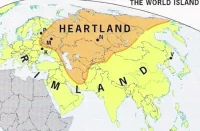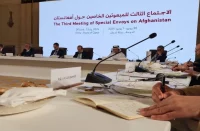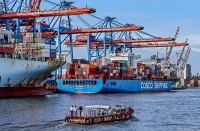Sherhasan Hasan (Afghanistan)
When the world media addresses any issues involving Afghanistan, it invariably mentions military clashes, bombings, killings, disruptions, refugees, deprivation, poverty, disease, terrorism, etc. For the last several decades, the Taliban, al-Qaeda, drugs and other fear-inducing concepts have been associated with the name of my homeland—Afghanistan.
The malicious game of double standards
Afghanistan has been the main victim of terrible events that shook the world and are plain to any sensible person. Unfortunately, the international community experienced fear and danger from these kinds of events only when cities and homes in the West were burning. It is upsetting that until now no one heard the screams of Afghans coming out of this hellhole. Surprisingly, world leaders are still deluding themselves as they try to convince the public that, having found the roots of terrorism in Afghanistan, they are now trying to eradicate it.
But the true situation is different: just as they found they found no weapons of mass destruction in Iraq, they have not yet found and, obviously, will not find the roots of international terrorism in Afghanistan. And that means there is no possibility of achieving victory over the industry of violence.
One of the reasons for the international community’s failure to find “the evil of transnational terrorism” has been the application of double standards in international politics.
Double standards are a natural property of human consciousness. It is human nature not to see the beam in our own eye, to feel prejudice towards others and to seek justification for our own evil deeds while condemning others. That aspect of human nature is particularly cynical in politics. The strong will always take advantage of their power and impose their concept of the world on the weak.
The Afghan scene provides clear confirmation of this thesis, especially in recent times: the world openly acknowledges the right of the strong to crush the weak.
I hope my fellow countrymen will not be offended, but today I will not talk about how valiant, courageous and brave we are in the proud tone we Afghans know so well. Over the course of our 5000 year history we have vanquished all aggressors who invaded our land, we have won our independence and we are well able to defend our homeland… I want to tell the truth, and the truth is that not even our current borders were defined by us—by Afghans. They are the result of a deal made by two empires—Russia and Britain.
In his book “Afghanistan and Central Asian Security” [Afganistan i bezopasnost’ Tsentral’noy Azii] (a collection of articles by professional Orientalists, primarily Afghan historians), renowned historian and political scientist Alexander Knyazev wrote the following: “The development of Afghanistan at the turn of the 21st century has largely been predetermined by events that occurred in the late 19th and early 20th centuries, when Afghanistan was formed as a state operating within the limits of independence and responsibility it was allowed as a compromise between the Russian and British empires. Afghanistan continued to be a target of geopolitical rivalry during the confrontation between two world systems in the second half of the 20th century. The new stage in the old Great Game began with the replacement of one of the main players—here, as in many other geopolitical theaters, the United States took over from Great Britain.”
Islamism perverted
Over the history of the rivalry between world powers, radical Islamic ideology gradually became a convenient tool for non-Islamic countries to use in pursuing their geopolitical interests.
After World War II ended and India was liberated, the victorious nations, including Great Britain, carefully sought military and political allies and tried to secure their political presence in the region. The emergence of the state of Pakistan became the first step toward the open use of radical Islamic ideas—as a political tool for achieving geopolitical goals.
Yuri Panichkin, Cand. Sc. (History), an expert on the Pakistani Pashtun, wrote in his monograph “The Formation of Pakistan and the Pashtun Question” [Obrazovaniye Pakistana i pushtunskiy vopros]: “With the end of World War II, India’s independence movement began gaining momentum, and regional groups with both national and regional objectives playing an ever greater role in the anti-colonial struggle. In September 1944, the new Viceroy of India, Lord Wavell, organized talks between Mahatma Gandhi and Mohammad Ali Jinnah through liberal federation chairman Tej Bahadur Sapru, who acted as intermediary. Jinnah insisted on the establishment of the Muslim state of Pakistan… London’s position on the India problem, which, was aimed at solving the problem when the war ended, began to take shape in 1939-1940. At that time Oxford University Professor T. Coopland was sent to India. He was assigned to study the situation in the country and prepare recommendations on how to maintain British influence on the Indian subcontinent. He concluded that without a British presence India would be threatened with complete Balkanization, which could result in new wars. The partition of India along religious lines and the granting of sovereignty to small princedoms and tribal territories under British auspices were seen as one option for containing the destructive forces.”
The cancer that is Kashmir
Pakistan did not give the Pashtuns the right of self-determination after India was partitioned, nor did it allow the Kashmiris to decide their own fate. Pakistan initiated a large-scale military incursion into Kashmir, and that forced Kashmiri Governor Raja Harisingh to declare the accession of his territories to India. When Kashmiri spiritual leader Sheikh Abdullah joined him, the Kashmiris were divided in two, as were the Pashtuns.
In the war against Kashmir, Pakistan very skillfully manipulated the religious feelings of the Pashtuns, calling them a volunteer Muslim army. And when the British began to criticize Pakistan’s actions, Pakistan responded that the Muslim bands were from the free Pashtun tribes, and the Pakistani government supposedly was unable to control them.
This situation has changed little today: on the one hand, Pakistan employs the Taliban, which primarily consists of Pashtuns from the free tribal zone, to destabilize the situation in Afghanistan, while on the other hand it tries to prove to the entire world that the Pashtuns are a savage people who cannot be controlled, and that they are the source of Islamic fundamentalism and terrorism.
The Kashmiri issue has thus become a cancerous tumor on the region and a vital issue for Pakistan’s foreign and domestic policy. Pashtuns from the free zone are seen as a potential irregular army for Pakistan.
Pakistan obviously has a carefully thought out scheme to try and keep the Pashtun tribes away from civilization and prevent them from being educated in their native language. The Pashtuns are given an extremist religious education so that in the future they can easily be used “in the name of Islam” to solve both the Kashmiri problem and a range of issues affecting Pakistan’s territorial integrity. Pakistan is considering no other political technologies, since its existence is based on extremist Islamic ideas.
The religious orphanage industry
Pakistan has made broad use of religious schools (madrassas) to achieve its strategic goals in Kashmir and Afghanistan. Madrassas have a long history in Pakistan, but their numbers began increasing after the Soviet intervention in Afghanistan. During the rule of General Zia-ul-Haq, they increased from one thousand to eleven thousand, and the number of Taliban studying in them reached almost one million. Zia-ul-Haq set aside land for construction of new madrassas and gave them moral and material support.
The Afghan war produced a large army of orphans. In addition, Afghan refugees were kept out, poverty was widespread across Pakistan and mainstream schools were inaccessible—and this is far from a complete list of the reasons why all the religious schools were rapidly filled and the number of Taliban studying in them quickly increased.
The madrassas were quickly turned into camps for training and teaching Afghan mujahedeen, and they continue to function as such for the Taliban militants. They are all supervised by Pakistan’s Inter-Services Intelligence Directorate (ISI).
Since the very beginning of its existence, Pakistan’s involvement in Islamic ideology has earned it strong financial support from the Arab world. But during the period we are looking at, rich Arab sheiks were especially generous with encouragement and financial support for the Pakistani madrassas.
Wealthy Arab countries not only supported Pakistan on the Kashmiri issue, they also generously financed the Afghan mujahedeen and their successors, the Taliban militants. Together with the financial aid, Islamic fundamentalists also relocated to Pakistan from Arab countries, bringing religious fanaticism, extremism and Wahhabism. Finally, al-Qaeda came along with them, together with a “dear and esteemed guest”: Osama bin Laden.
The origins and development of fundamentalism in Islam are well documented in the book by an Afghan scholar and historian now living in the United States, Professor Mohammed Hassan Kakar, “A Trip to my Homeland: The Taliban and Islamic Fundamentalism” [Poyezdka na rodinu, Taliban i islamskiy fundamentalizm]. Professor Kakar examines the centuries-long history from the defeat of Baghdad by Genghis Khan’s grandson, Hulagu, in 1258, from Ibn Taymiyyah to bin Laden.
The cycle of jihad: the perpetrators and the victims
According to various unofficial Pakistani sources, before the American invasion in 2001 armed groups in Afghanistan included the following: 25 thousand Afghan Taliban, 20 thousand Pakistani Taliban and members of various mujahedeen groups, 15 thousand foreign mercenaries and volunteers, and 10 thousand Pakistani airborne soldiers under the command of retired General Abdurrahman. The Pakistani soldiers returned to their positions before the operation began (obviously, not without the assistance of the Western Allies). Seven thousand were killed, and another 5-7 thousand were taken prisoner by the Northern Alliance. Ten thousand Afghan Taliban returned to their homes, and approximately 30 thousand, including foreigners, fled and scattered across Pakistan; they gradually returned to the free Pashtun territories.
Pakistan currently has about 37 thousand madrassas and two thousand unofficial military training centers, where about 4 million Taliban study. Of that number, 700 madrassas are located in the free Pashtun territories; 35 madrassas and 40 military training centers are located in Gilgit near the borders with India and China.
Pakistan officially has about 30 fundamentalist Islamic parties and about 11 armed religious extremist groups. In addition to the Pakistani extremists, there are al-Qaeda Arabs (approximately 13 thousand), 11 thousand Uzbeks along with their families and four thousand immigrants from the North Caucasus, as well as Tajiks, Uighurs, Bengalis, etc.
The territory of the free Pashtun tribes has been used by the ISI, CIA, extremists from the Arab world, international mafia organizations and narcotraffickers for 30 years. Only the reasons for their actions change: in the 1980s the reason was jihad against the Soviet occupiers; in the 1990s it was jihad against jihad, and since 2001 it has been jihad against America and NATO.
Abandoning democracy and peace
In October 2001, the Americans entered Afghanistan and said they would fight against terrorists and the drug industry and for human rights, democracy and freedom. I must say that for eight years these goals not only have not been realized, they have become even more complicated.
It is laughable to say that the international community and the powerful military and intelligence machine of the United States and NATO are fighting extremists, terrorists and narco-bandits with the extensive capabilities of a regional and international agent network and the state and civil support of the entire world at their disposal—yet they still do not know where bin Laden, Mullah Omar and other terrorist ringleaders are located. What do they live on, how are they financed, where do they get their weapons and ammunition? These questions remain unanswered. Obviously, none of that support comes from Afghanistan.
It gets even funnier when we see that the United States and NATO are building powerful military and air bases in Afghanistan and saying that they are for fighting the Taliban and al-Qaeda terrorists. However, they themselves admit that no more than 100 al-Qaeda fighters remain in Afghanistan, as Barack Obama’s National Security Advisor, General James Jones, testified in congressional hearings last year.
It is outrageous when under that rallying cry our homes, villages and towns are bombed and civilians killed: women, old people and children.
It is inhuman when armed US and NATO soldiers under the slogan of fighting terrorism and supporting democracy and human rights break into the homes of Afghans in the middle of the night and shoot everyone they encounter, and then claim they were Taliban. I have never seen those kinds of actions even in grisly documentaries about the German Nazis.
War, murder, poverty, disease, wartime lifestyle and generally everything that we call a crisis are becoming the norm for Afghanistan and for Pashtuns. Evil breeds evil, and this vicious circle is likely the lot of our unfortunate people.
The worst thing is that the people around us look upon this in silence, as though indifferent. Everyone has obviously become accustomed to the terrible lifestyle of the Afghans—not only in Afghanistan but throughout the world. Or perhaps the brazen principle of “double standards” continues to persuade people around the world that the powerful, wealthy and wise rulers in the White House and NATO are acting properly.
But all normal people in the world surely understand a simple truth—“don’t expect anything good to come of it if you come into someone’s home carrying a sword!”
***
The war goes on. The mujahideen waged jihad, and their successors, the Taliban, are continuing it. Meanwhile, the simple Afghan peasant could not care less whether an armed soldier has entered his home under a decree from the Politburo of the Central Committee of the CPSU or under a UN Security Council mandate.
Sherhasan Hasan is a member of the Afghan community in Russia. The article was published originally in Russian at Afghanistan.ru














Pingback: Outside Sources of Afghanistan's Woes | Oriental Review | arablives
Pingback: Outside Sources of Afghanistan's Woes | Oriental Review | Headlines Today
Pingback: Outside Sources of Afghanistan's Woes | Oriental Review | Afghanistan Today
Lots of Good information in your posting, I bookmarked your blog post so I can visit again in the near future, Cheers :)
Thanks for sharing, I found this article, while googling for some downloads and ran across this website, useful comments and good points made.
It is great to have the ability to read a good quality post with useful information on topics that plenty are interested on. The point that the data indicated are all first hand on real experiences even assist more. Go on doing what you do as we enjoy reading your work.
Typical! Everything that has ever happened in Afghanistan for centuries is someone else’s fault. Poor Afghanistan